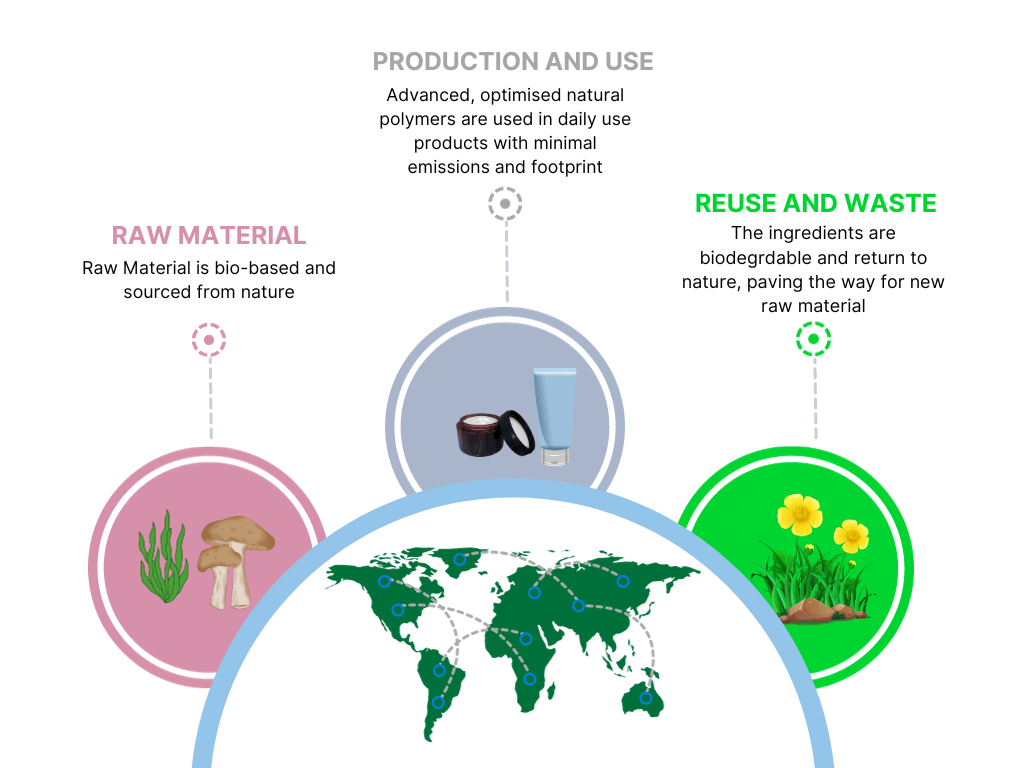- Transitioning to a greener economy and lifestyle involves overcoming several challenges collaboratively
- There have been innovations in sustainable products and services and a mindset shift towards adopting eco-friendly practices
- The global transition from synthetic polymers to sustainable alternatives marks a pivotal moment in humanity’s collective pursuit of environmental stewardship.
- By embracing plant-based biopolymers, harnessing the potential of Biosurfactants, & leveraging the versatility of microcapsules, industries & communities alike contribute.
- The journey toward a greener tomorrow demands collaborative efforts, innovative solutions, and a steadfast commitment to sustainable practices.
- Through conscientious decision-making and proactive engagement, we can collectively mitigate the environmental impact of plastic pollution.
- At the same time, we can pave the way for a more harmonious coexistence with the natural world.
Overcoming Challenges in Sustainability
Overcoming challenges in sustainability is a multifaceted challenge demanding collaborative efforts, innovative solutions, and resolute commitments from all sectors of society.
Balancing cost-effectiveness with scalability, ensuring widespread adoption, and optimizing manufacturing processes remain critical focus areas. Moreover, sustainable alternatives must match or exceed the performance and functionality of synthetic polymers, including properties such as durability, strength, flexibility, and stability in their various applications across industries.
Overcoming challenges in sustainability also requires the unlocking of sustainable finance, along with collaborative efforts between policymakers, industries, and research institutions, which are imperative for a seamless transition to a more sustainable future:
- Industries can collectively work on improving the scalability, cost-effectiveness, and performance of their sustainable solutions through shared knowledge, research initiatives, and technological innovations.
- Policymakers can facilitate this transition by creating supportive regulations that incentivize the adoption of eco-friendly materials and practices.
- Researchers can drive enhancements by exploring new materials, refining production techniques, and improving sustainable alternatives.
There has been a shift in consumer demand, especially post the pandemic, and consumers, armed with knowledge, have become catalysts for change. Their influence on market dynamics has pushed policymakers to bring in more environmentally friendly regulations, and industries to adopt more sustainable products as well as environmentally and socially friendly practices.
To remain competitive, cosmetics and personal care companies are increasingly integrating sustainability into their business models – including, but not limited to, sourcing eco-friendly ingredients, adopting natural formulations, reducing carbon footprints, and using sustainable packaging.
Adopting natural formulations and ingredients in the beauty industry
The pursuit of sustainability is driving innovations in the industry, but biopolymers have been gaining popularity in the personal care industry due to their eco-friendly and sustainable nature. They have diverse applications, across various products, and offer numerous benefits with their use. Here are some key applications of biopolymers in the personal care industry:
- Skincare, sunscreens, and protective formulations: biopolymers like hyaluronic acid and xanthan gum provide hydration and plumpness and act as emollients and moisturisers. Some biopolymers also create thin films over the skin’s surface, enhancing smoothness and protecting against environmental stressors. Biopolymers also assist in stabilising sunscreen formulations while also contributing to their texture and spreadability.
- Hair care: Biopolymers such as guar gum or hydrolyzed proteins can act as conditioning agents. They also contribute viscosity to shampoos and conditioners, offering a pleasant texture without weighing down the hair.
- Natural surfactants and cleansers: Biopolymers like saponins or algal extracts can serve as gentle cleansing agents in facial cleansers or body washes.
- Anti-aging and anti-wrinkle products: Biopolymers like peptides or plant-based polymers are used as substitutes for collagen, helping to reduce the appearance of wrinkles and improving skin elasticity.
- Microencapsulation: Biopolymers are used in microencapsulation techniques to encapsulate active ingredients, enabling controlled release in products like lotions or serums.
Other nature-based Innovations for a Sustainable Future
While several challenges like scalability and performance persist, technology, innovation, and research have been key to developing more innovative solutions replacing conventional products and methodologies and finding diverse applications across industries:
Biopolymer Reinforcement for Packaging Solutions
The integration of plant-based biopolymers in packaging solutions has emerged as a promising avenue to reduce the environmental impact of traditional plastic packaging. By leveraging the natural properties of biopolymers, manufacturers can produce durable and versatile packaging materials that offer enhanced biodegradability and compostability.
This shift not only mitigates the burden on landfills but also minimises the risk of harmful pollutants leaching into the soil and water systems, ultimately reducing our reliance on traditional plastics.
It fosters a more sustainable approach to product packaging and distribution.
Eco-Friendly Remediation with Biosurfactants
Surfactants, conventionally, have been the compounds utilised for the cleansing and foam-creating actions in shampoos, body washes, and cleansers, and have been petrochemical-based.
Beyond their use as alternatives in personal care products, Biosurfactants, in turn, have demonstrated significant potential in environmental remediation efforts. These biodegradable compounds exhibit remarkable abilities to facilitate the degradation of hydrocarbons and other pollutants. It makes them valuable tools in the restoration of contaminated sites and the mitigation of oil spills. By harnessing the natural properties of Biosurfactants, environmental engineers and scientists can effectively accelerate the remediation process.
Generally, it minimises the ecological impact, restoring ecosystems and safeguarding biodiversity for future generations.
Precision Delivery Systems with Microcapsules
The versatility of microcapsules extends beyond personal care applications, finding utility in developing precision delivery systems for various industries like agriculture and pharmaceuticals.
In agriculture, for instance, microcapsules enable targeted delivery of fertilisers and pesticides, reducing the overall environmental footprint of agricultural practices. By minimising the dispersion of chemicals into surrounding ecosystems, these microcapsules facilitate more controlled and efficient nutrient and pest management.
It promotes sustainable agricultural practices and safeguarding soil and water quality for long-term ecological resilience.
It’s time to commit to nature
Nature works in an organised, structured, and cyclical manner, and it is time to take inspiration from nature and look at processes holistically from birth to end – or what has been defined as the circular economy.
In a circular economy, the emphasis is on products sourced from nature and designed to return or be reused until they reintegrate into nature.
To support a circular economy, and humanity’s future, there has been a strong shift towards eco-friendly materials and sustainable practices. Eco-friendly materials are finding applications in various industries from construction to personal care. Moreover, sustainable practices and materials also help bring down emissions and lower carbon footprints. For e.g.biofuels derived from biomass can significantly lower emissions compared to traditional fossil fuels, with estimates suggesting reductions between 60 to 90% in CO2 emissions. And, plant-based biopolymers can potentially reduce carbon emissions by a notable margin. Greenitio found reductions in emissions of up to 90% for its products, especially if sourced sustainably and produced using renewable energy.
Embracing sustainability: A collective commitment for a resilient future
In navigating the current and complex situation of climate change and a transition to a sustainable future, embracing sustainable alternatives emerges not just as a choice but as a collective responsibility. Bringing such solutions to the mass market and adopting them will lead to a more resilient future and better living standards. Consumer demand coupled with regulations and governance have triggered a strong industry-wide shift towards eco-friendly materials and sustainable practices, pivotal for wider adoption of products and practices, and ultimately achieving the 2030 Agenda.



